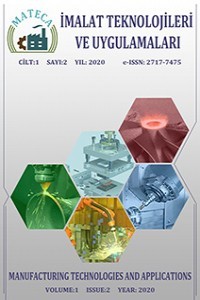Cr(VI) Elektrokaplama Banyolarının Cr(III) Banyolarına Dönüştürülmesinde Etkin Faktörlerin Belirlenmesi
Krom (Cr) kaplama dekoratif ve fonksiyonel amaçlı yaygın biçimde kullanılmaktadır. Yüksek sertlik, parlak görünüm, mükemmel aşınma ve korozyon direncine sahiptirler. Cr(VI) toksik bir malzemedir. Bu yüzden Cr(VI) banyolarından elde edilen Cr kaplama, çalışan sağlığı ve çevre açısından büyük risk oluşturmaktadır. Bu yüzden benzer kalite ve özelliklere sahip, ayrıca toksik ve çevreye zararlı etkisi olmayan Cr(III) banyoları, Cr(VI)’ya iyi bir alternatiftir. Daha az zararlı ve kolay arıtılabilir olması tercih sebebidir.
Bu makalenin amacı, mevcut Cr(VI) banyolarının uygun maliyetle Cr(III) banyosuna dönüştürülerek doğaya deşarjının önlenmesidir. Bunu sağlamak için 3 farklı firmadan Cr(VI) kaplama banyosu toplanmış, kimyasal dönüşüm yöntemli ile Cr(III) kaplama banyosuna dönüştürme çalışması yapılmıştır. Dönüşüm sırasında Cr kaplamanın kalitesini etkileyen önemli faktörleri belirlemek için deneysel tasarım metodolojileri uygulanmıştır. Ana faktörlerin etkilerini ve etkileşimlerini belirlemek ve dönüşüm sürecini optimize etmek için ½ kesirli faktöriyel deney tasarım metodu kullanılmıştır. Sonuçlar istatistiksel olarak değerlendirilmiş ve optimum dönüşüm parametreleri belirlenmiştir.
Anahtar Kelimeler:
Cr(III) elektrokaplama, Cr(VI) elektrokaplama banyosu, Kimyasal dönüşüm, metal kaplama.
___
- Abner Brenner, Polly Burkhead, C. J. (1948). Physical Properties of Electrodeposited Chromium. Part of the Journal of Research of the National Bureau of Standards Physical, 40(January), 31–59.
- Ehasanul Haque, M., Asadul Hoque, M., Mayeedul Islam, M., Saidul Islam, M., Mohammad Mustafa, C., & Carlos Cardoso Martins, R. (2017). Effect of Various Operating Effect of Various Operating Parameters on Trivalent Chromium Electroplating. Journal of Scientific Research & Reports Nuclear Materials Authority Cairo, Egypt. Panagopoulos Takuo Sakon, 13(3), 1–9. https://doi.org/10.9734/JSRR/2017/31411
- Fink, C. . (1926). Process of electrodepositing chromium and of preparing baths therefor (Patent No. 1,581,188).
- Fink, C. . (1931). Process of producing chromium-plated articles with mirrorlike scratch finish or the like surfaces (Patent No. 1,802,463).
- Ghaziof, S., Raeissi, K., & Golozar, M. A. (2010). Improving the corrosion performance of Cr-C amorphous coatings on steel substrate by modifying the steel surface preparation. Surface and Coatings Technology, 205(7), 2174–2183. https://doi.org/10.1016/j.surfcoat.2010.08.123
- Katirci, R., & Altınsarı, A. (2020). The conversion of the waste Cr(VI) electroplating bath to Cr(III) electroplating bath. International Journal of Environmental Science and Technology, 17(10), 4205–4216. https://doi.org/10.1007/s13762-020-02765-2
- Katırcı, R. (2016). A chrome coating from a trivalent chromium bath containing extremely low concentration of Cr3+ ions. International Journal of Surface Science and Engineering, 10(1), 73. https://doi.org/10.1504/IJSURFSE.2016.075318
- Lee, J.-Y., Kim, M., & Kwon, S.-C. (2009). Effect of polyethylene glycol on electrochemically deposited trivalent chromium layers. Transactions of Nonferrous Metals Society of China, 19(4), 819–823. https://doi.org/10.1016/S1003-6326(08)60357-X Liang, A., Li, Y., Liang, H., Ni, L., & Zhang, J. (2017). A favorable chromium coating electrodeposited from Cr(III) electrolyte reveals anti-wear performance similar to conventional hard chromium. Materials Letters, 189, 221–224. https://doi.org/10.1016/j.matlet.2016.12.022
- Liao, C. W., Lee, H. Bin, Hou, K. H., Jian, S. Y., Lu, C. E., & Ger, M. Der. (2016). Characterization of the Cr-C/Si3N4 Composite Coatings Electroplated from a Trivalent Chromium Bath. Electrochimica Acta, 209, 244–253. https://doi.org/10.1016/j.electacta.2016.05.084
- Nam, K.-S., Lee, K.-H., Kwon, S.-C., Lee, D. Y., & Song, Y.-S. (2004). Improved wear and corrosion resistance of chromium(III) plating by oxynitrocarburising and steam oxidation. Materials Letters, 58(27–28), 3540–3544. https://doi.org/10.1016/j.matlet.2004.06.038
- Phuong, N. Van, Kwon, S. C., Lee, J. Y., Lee, J. H., & Lee, K. H. (2012). The effects of pH and polyethylene glycol on the Cr(III) solution chemistry and electrodeposition of chromium. Surface and Coatings Technology, 206(21), 4349–4355. https://doi.org/10.1016/j.surfcoat.2012.04.025
- Surviliene, S., Jasulaitiene, V., Nivinskiene, O., & Češuniene, A. (2007). Effect of hydrazine and hydroxylaminophosphate on chrome plating from trivalent electrolytes. Applied Surface Science, 253(16), 6738–6743. https://doi.org/10.1016/j.apsusc.2007.01.122
- Surviliene, S., Nivinskiene, O., Češuniene, A., & Selskis, A. (2006). Effect of Cr(III) solution chemistry on electrodeposition of chromium. Journal of Applied Electrochemistry, 36(6), 649–654. https://doi.org/10.1007/s10800-005-9105-8
- Zeng, Z., Sun, Y., & Zhang, J. (2009). The electrochemical reduction mechanism of trivalent chromium in the presence of formic acid. Electrochemistry Communications, 11(2), 331–334. https://doi.org/10.1016/J.ELECOM.2008.11.055
- Yayın Aralığı: Yılda 3 Sayı
- Başlangıç: 2020
- Yayıncı: Mustafa GÜNAY
